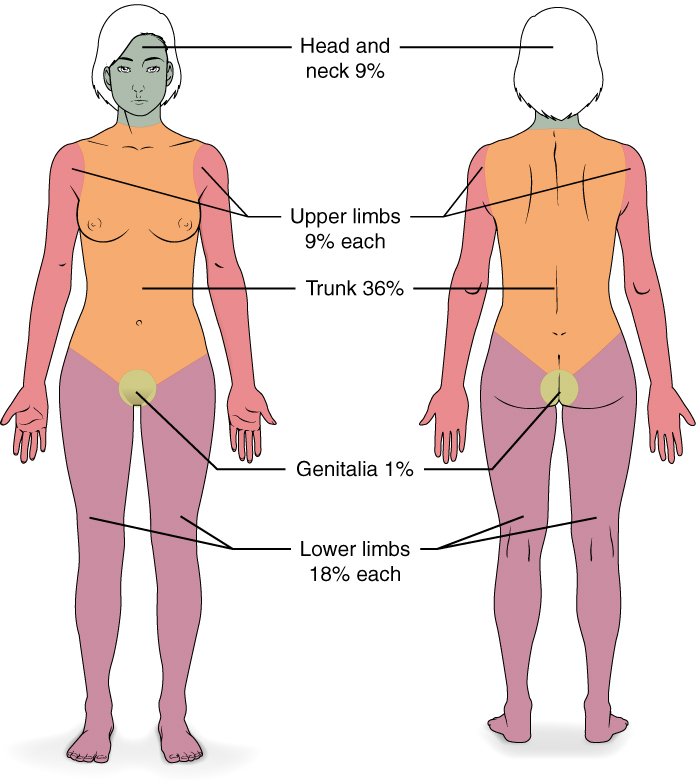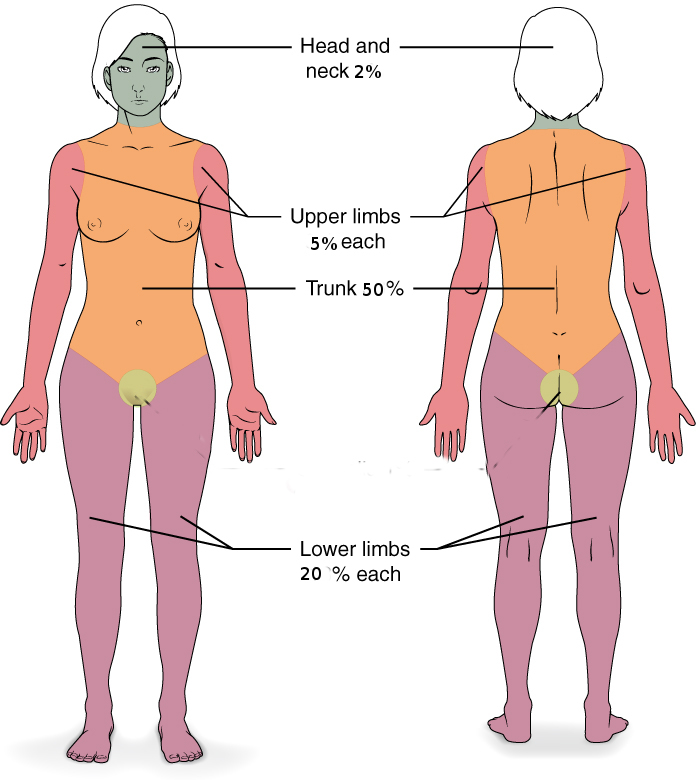The Parkland Replacement Fluids calculator computes the amount of fluids required for the first 24 hours in a burn patient using the Parkland Formula and the patient's weight (mass) and percent of the body surface area burned.
INSTRUCTIONS: Choose units and enter the following:
- (m) Weight of Patient
- (A) Percent of Patients Body Surface Area Covered in Burns. CLICK HERE to calculate percent of body burned.
Replacement Fluids (V): The calculator returns the volume of replacement fluids in liters (L). However, this can be automatically converted to other volume units (e.g. cups) via the pull-down menu.
Related Calculators:
- To compute the Body Surface Area using the Mosteller, Gahan and George, Boyd, DuBois, Haycock, Fujimoto, Takahira or Wang Hihara formulas, [Private Equation].
- To compute the percent of human body that is burned using the Wallace Rule of Nines, CLICK HERE.
- To compute the percent of a human body that is burned using the Rule of Fives for obese patients, CLICK HERE.
Burn Surface Area
Wallace Rule of Nines Rule of Fives (Obese Patients)
Rule of Fives (Obese Patients)  Percent of Burned BodyThe Wallace Rule of Nines can be used to approximate the percent of a patient that is burned. It applies a percent of Body Surface Area, often a multiple of 9, for different body parts as follows:
Percent of Burned BodyThe Wallace Rule of Nines can be used to approximate the percent of a patient that is burned. It applies a percent of Body Surface Area, often a multiple of 9, for different body parts as follows:
- (9%) Entire head
- (9%) Complete left arm
- (9%) Complete right arm
- (9%) Entire chest
- (9%) Entire abdomen
- (18%) Complete back
- (1%) Groin
- (18%) Complete left leg
- (18%) Complete right leg
The Rule of Fives can be used to approximate the percent of an obese patient that is burned. It applies a percent of Body Surface Area, and differs from the Wallace Rule of Nines in that it applies a larger portion of the body surface area to the trunk and legs as follows:
- (2%) Entire head
- (5%) Complete left arm
- (5%) Complete right arm
- (50%) Trunk
- (20%) Complete left leg
- (20%) Complete right leg
Body Surface Area (BSA) is the measured or calculated surface area of a human body frequently used in physiology and medicine. For many clinical purposes BSA is a better indicator of metabolic mass than body weight because it is less affected by abnormal adipose mass. Estimation of BSA is simpler than many measures of volume.
| BSA Calculators vs Inputs | |||
| Method | Height | Weight | Gender |
| Mosteller | x | x | |
| Gehan and George | x | x | |
| Boyd | x | x | |
| DuBois | x | x | |
| Haycock | x | x | |
| Fujimoto | x | x | |
| Takahira | x | x | |
| Schlick | x | x | x |
| Costeff | x | ||
| Wang Hihara | x | x | |
Demographic BSA Means
| Age Range | Male | Female |
|---|---|---|
| Neonate | 0.243 m² | 0.234 m² |
| 2 years old | 0.563 m² | 0.54 m² |
| 5 years old | 0.787 m² | 0.771 m² |
| 10 years old | 1.236 m² | 1.245 m² |
| 13 years old | 1.603 m² | 1.55 m² |
| 18 years old | 1.98 m² | 1.726 m² |
| 20 to 79 years old | 2.06 m² | 1.83 m² |
| 80 and above | 1.92 m² | 1.638 m² |
Body Surface Area (BSA) Calculators
- Mosteller formula Body Surface Area Calculator
- Gehan and George formula Body Surface Area Calculator
- Boyd formula Body Surface Area Calculator
- DuBois formula Body Surface Area Calculator
- Haycock formula Body Surface Area Calculator
- Fujimoto formula Body Surface Area Calculator
- Takahira formula Body Surface Area Calculator
- Costeff formula Body Surface Area Calculator
- Wang Hihara Body Surface Area Calculator
- Schlick Body Surface Area Calculator
- Body Surface Area Comparison with Averages
Other BSA Applications
- The BSA Compare function lets you enter a body surface area and choose a demographic (above) to compute the percent compared to the mean.
- Wallace Rule of Nines: This computes a percentage of the human body for burn victims based on percentages allocated to different body parts.
- Rule of Fives: This computes a percentage of the human body for obese burn victims.
- Parkland Replacement Fluid: This compute the volume of replacement fluids needed in the first 24 hours based on the patients weight (mass) and the percent of their body that has been burned.
- BSA Percent: This computes a body surface area based on the total body surface area and a percent..
References:
- Image of Human Body from OpenStax College. Used through CC 3.0. Source Anatomy & Physiology, Connexions Web site. http://cnx.org/content/col11496/1.6/, Jun 19, 2013.
Dedication:
For Scout.

